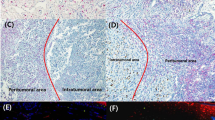Summary
Flow cytometric analysis of nuclear DNA content is valuable for indicating ploidy- and proliferation abnormalities in surgically removed human malignant melanomas. In 35 primary cutaneous melanomas, 20 metastases of melanoma in skin and lymph nodes, and 16 nevi the DNA distribution was analyzed by flow cytometry and compared with a variety of histological parameters and the subsequent clinical course.
Heteroploid DNA distributions with increased polyploid or aneuploid fractions were found in 26 primary melanomas (74%), 14 metastases (70%), and 4 nevi (25%) indicating tumor clones with an abnormal nuclear DNA content. Three or more cell clones in a single biopsy was found in 10 primary melanomas, 2 metastases, and 1 nevus.
The frequency of heteroploidy was significantly higher in primary and secondary melanomas than in nevi (p< 0.001) and was correlated significantly with a high mitotic acitivity (p<0.002), marked nuclear pleomorphism (p<0.01), large nucleoli (p<0.01) and a thickness of the primary melanoma of more than 2.25 mm (p<0.02). Such histologic findings in malignant melanomas have been shown previously to be correlated with a bad prognosis. No significant correlation was found between heteroploidy and the histologic type of melanoma or the level of invasion. A 2-year clinical follow-up showed that more patients died from melanoma if the DNA distribution in the primary or secondary melanoma was heteroploid (6/26; 23% and 8/13; 62% respectively) than if it was diploid (0/9; 0% and 2/5; 40% respectively). However, the differences were not statistically significant.
It is concluded that heteroploidy 1) is not an absolute criterion of malignancy, 2) is significantly correlated with histologic features indicating marked cellular anaplasia, and 3) is apparently correlated with a bad prognosis.
Similar content being viewed by others
References
Balch CM, Murad TM, Soong S-J, Ingalls AL, Halpern NB, Maddox WA (1978) A multifactorial analysis of melanoma: Prognostic histopathological features comparing Clark’s and Breslow’s staging methods. Ann Surg 188:732–742
Barlogie B, Drewinko B, Schumann J, Göhde W, Dosik G, Latreille J, Johnston DA, Freireich EJ (1980) Cellular DNA content as a marker of neoplasia in man. Am J Med 69:195–203
Breslow A (1970) Thickness, cross-sectional areas and depth of invasion in the prognosis of cutaneous melanoma. Ann Surg 1972:902–908
Clark WH, From L, Bernardina EA, Mihm MC (1969) The histogenesis and biologic behaviour of primary human malignant melanomas of the skin. Cancer Res 29:705–727
Drzewiecki KT, Christensen HE, Ladefoged C, Poulsen H (1980) Clinical course of cutaneous malignant melanoma related to histopathological criteria of primary tumour. Scand J Plast Reconstr Surg 14:229–234
Eldh J, Boeryd B, Peterson L-E (1978) Prognostic factors in cutaneous malignant melanoma in stage I. A clinical, morphological and multivariate analysis. Scanc J Plast Reconstr Surg 12:243–255
Esch EP van der, Cascinelli N, Preda F, Morabito A, Bufalino R (1981) Stage I melanoma of the skin: Evaluation of prognosis according to histologic characteristics. Cancer 48:1668–1673
Frentz G, Møller U, Christensen I (1980) DNA flowcytometry on human epidermis I. Methodologic studies on normal skin. J Invest Dermatol 74:119–122
Kraemer PM, Petersen DF, van Dilla MA (1971) DNA constancy in heteroploidy and the stem line theory of tumors. Science 174:714–717
Laerum OD, Farsund T (1981) Clinical application of flowcytometry: A review. Cytometry 2:1–13
Larsen TE, Grude TH (1978) A retrospective histological study of 669 cases of primary cutaneous malignant melanoma in clinical stage I. 2. The relation of cell type, pigmentation, atypia, and mitotic count to histological type and prognosis. Acta Pathol Microbiol Scand, Sect A 86:513–522
Larsen TE, Grude TH (1979) A retrospective histological study of 669 cases of primary cutaneous malignant melanoma in clinical stage I. 7. The relative prognostic value of various clinical and histological features. The result of a stepwise multiple regression analysis of 553 of these cases. Acta Pathol Microbiol Scand, Sect A 87:469–477
Larsen JK, Byskov AG, Grinsted J (1981) Growth and differentiation of fetal mouse gonads in culture studied by flowcytometry on nuclear suspensions. Acta Pathol Microbiol Scand, Sect A Suppl 274:178–182
Little JH (1972) Histology and prognosis in cutaneous malignant melanoma. In: Melanoma and skin cancer. Proceedings of the international cancer conference, Sydney 1972. Blight VCN, Government Printer, Sydney, pp 107–120
Malec-Olovson E (1978) Malignant melanoma of the skin in Sweden. Epidemiological and clinic-histopathological study. Thesis. Karolinska Institutet, Stockholm, Sweden
McGovern VJ (1970) The classification of melanoma and its relationship with prognosis. Pathology 2:85–98
McGovern VJ, Shaw HM, Milton GW, Farago GA (1979) Prognostic significance of the histological features of malignant melanoma. Histopathology 3:385–393
Melamed MR, Mullaney PF, Mendelsohn ML (1979) Flow cytometry and sorting. John Wiley & Sons, New York
Nowell PC (1978) Tumors as clonal proliferation. Virchows Arch [Cell Pathol] 29:145–150
Olsen G (1966) The malignant melanoma of the skin. New theories based on a study of 500 cases. Thesis. Acta Chir Scand Suppl 365
Pedersen T, Larsen JK, Krarup T (1978) Characterization of bladder tumours by flow cytometry on bladder washings. Eur Urol 4:351–355
Petersen NC, Bodenham DC, Lloyd OC (1962) Malignant melanomas of the skin. A study of the origin, development, aetiology, spread, treatment, and prognosis. Br J Plast Surg 15:49–94
Schmoeckel C, Braun-Falco O (1978) Prognostic index in malignant melanoma. Arch Dermatol 114:871–873
Søndergaard K (1980) The intra-lesional variation of type, level of invasion, and tumour thickness of primary cutaneous malignant melanoma. 55 malignant melanomas studied by serial block technique. Acta Pathol Microbiol Scand, Sect A 88:269–274
Søndergaard K, Hou-Jensen K (1977) Histologi og prognose ved kutant malignt melanom. Ugeskr Læg 139:2993–2996
Søndergaard K, Olsen G (1980) Malignant melanoma of the foot. A clinicopathological study of 125 primary cutaneous malignant melanomas. Acta Pathol Microbiol Scand, Sect A 88:275–283
Whang-Peng I, Chretien P, Knutsen T (1970) Polyploidy in malignant melanoma. Cancer 25:1216–1223
Author information
Authors and Affiliations
Rights and permissions
About this article
Cite this article
Søndergaard, K., Larsen, J.K., Møller, U. et al. DNA ploidy-characteristics of human malignant melanoma analysed by flow cytometry and compared with histology and clinical course. Virchows Archiv B Cell Pathol 42, 43–52 (1983). https://doi.org/10.1007/BF02890369
Received:
Accepted:
Published:
Issue Date:
DOI: https://doi.org/10.1007/BF02890369




